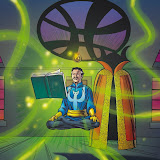
Tuesday, November 27, 2007
Balloon Placement Part 3
Allen gave his opinion about making room for the word balloons and it occurred to me. Why not draw the balloons in? The Old-School guys would actually pencil the dialogue in and draw around it. Less work for the penciler I guess. This page is from an old issue of Dr. Solar. Published by Western Publishing. I think they may have typeset the words.

Subscribe to:
Post Comments (Atom)


4 comments:
Many artists actually work this way. Especially in the "indie" and "manga" crowds. There are good arguments for and against this technique.
On the positive side, if the artist draws his own balloons, s/he has more control over the placement and therefore the design of the page. Hand-drawn balloons look more "organic" and more like part of the artwork, instead of looking like a separate element dropped on top. It can be less work for the artist who otherwise may draw elaborate backgrounds, only to have them covered up by balloons afterwards.
However, doing the balloons separately has distinct advantages. For one thing, it can be difficult to gage how big the balloons should be during the penciling stage. If the artist draws the balloons to small, there won't be enough room for the lettering, and it will look cramped, and vice-versa. Often, the dialogue is edited even after the story is lettered, so keeping separate digital files is the easiest way to make changes without fussing with the art. Also, this is invaluable when dealing with foreign translations, where the balloon shapes may end up completely different from language to language.
Personally, I'm a bit torn. I love the hand-drawn look when it is done well (that Dr. Solar page looks awful). I'd like to try that method sometime, just to see how it turns out. On the other, more practical hand, keeping the lettering & balloons separate just makes good common sense if you want to be flexible with the artwork.
Personally, I much prefer hand-drawing the balloons and hand lettering the dialogue and captions. Right on the boards, old school. I'm a pretty decent letterer, I think, and I get more of a thrill from having a page that is complete and can be read. In all the pages that I've done where the lettering is meant to be added via computer, it just looks empty to me. There have been a few things I've done where I've hand-lettered it and hand-drawn the balloons, and then went in and re-did the lettering on computer, leaving the balloons. The problem I've noticed on things that have been computer lettered is the utter disregard the writer and editor have for balloon placement. The problem is that the writer-types just want to WRITE so damn much. Blah blah blah. 50-100 word blocks of text that they just slap right over the artwork any old way. Anyway, I have taken to incorporating balloon placements right into my initial thumbnails and layouts, and that helps a lot. Otherwise, I do the grid thing.
That page Don showed looks awesome, although I probably would have done the balloons differently.
I leave the lettering up to the letterer. my hand drawn balloons look awkward and you can never predict how chatty a writer or editor can be.
But then, a writer can ask for a dozen things in a panel never imagining that a balloon could cover what's in the BG.
The page I've posted shows the art on the lower part of the panel. I think that the more 'structured' a page gets with an area for art and an area for balloons, it would affect your camera angles.
The letterer should be just as concerned with the quality of the end result as the artists- if they don't complement the work , artists won't want them lettering their stuff, and they won't get any more jobs.
Writer is writing too much? Isn't that what editors are for?
I think that the separate balloon overlay can work both aesthetically and operationally- it sure is easier to add or subtract text, balloons, effect after the fact.
Post a Comment